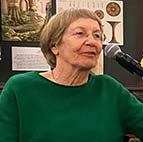

Selina Cooper
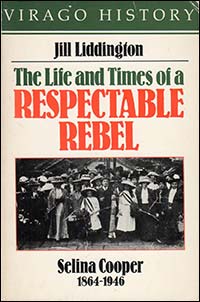 My determination to write a biography of Selina Cooper sprang from the oral history interviews that Jill Norris and I recorded with her daughter Mary in 1976. In May 1977, I had almost finished typing the final draft of One Hand Tied Behind Us. I decided to go back to Nelson to record a third and final interview with Mary, to check a few details. Mary still lived in the very same house in Nelson that she'd moved into with her parent in 1901.
My determination to write a biography of Selina Cooper sprang from the oral history interviews that Jill Norris and I recorded with her daughter Mary in 1976. In May 1977, I had almost finished typing the final draft of One Hand Tied Behind Us. I decided to go back to Nelson to record a third and final interview with Mary, to check a few details. Mary still lived in the very same house in Nelson that she'd moved into with her parent in 1901.
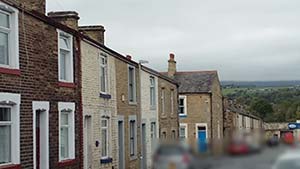
St Mary's Street, Nelson,just north of Burnley
To my complete surprise, she showed me handfuls of photographs and letters, news-cuttings and pamphlets that her mother had kept up to her death in 1946 - and which Mary had retained afterwards, but put to the back of her mind.
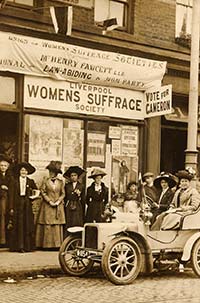 I subsequently recorded eight further interviews with Mary before her death in 1983. With each visit, Mary opened up to me her rich reserve of memories and family papers. I seldom left the house without an armful of photographs and letters - which I deposited in the Lancashire Record Office at Preston.
I subsequently recorded eight further interviews with Mary before her death in 1983. With each visit, Mary opened up to me her rich reserve of memories and family papers. I seldom left the house without an armful of photographs and letters - which I deposited in the Lancashire Record Office at Preston.
Pictured right: Liverpool Suffrage Society, by-election 1910 (seated far right). Click to enlarge
There was real excitement in tracking the forgotten story of a radical suffragist. Selina Cooper left full-time school aged 11 to work as a half-timer in a local cotton mill, and on her thirteenth birthday begun work full-time as a 'cotton operative'. In 1900 she was swept up by suffragists Esther Roper and Eva Gore-Booth, collecting signatures for the women cotton workers' petition, and Selina accompanied it down to Westminster in 1901 ~ Radical Suffragists. Perhaps Selina's most remarkable achievement, given the abrupt ending of her education, was that she was talent-spotted by Mrs Fawcett's growing NUWSS, and from 1906 was employed as a NUWSS organizer, speaking around the country.
Women's Suffrage Society, Nelson station, June 1911. (Centre front, Mary; immediately left, Selina; immediately right, Robert Cooper holding rolled banner). Click to enlarge
Selina Cooper always remained rooted in her own community. In 1911, she helped organize the Nelson delegation down to London for a 40,000-strong suffrage procession. And in 1913, at the finale of the great NUWSS Suffrage Pilgrimage, she spoke in Hyde Park on the same platform at Mrs Fawcett herself.
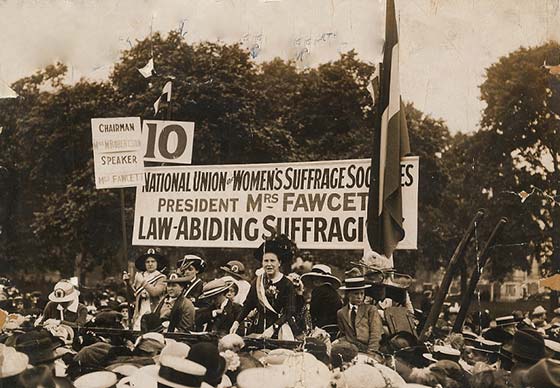
1913 pilgrimage, Selina (seated, centre), speaking in Hyde Park.
This Hyde Park image has been widely reproduced (including a giant enlargement displayed at the front of the Women's Library at LSE). Here however is the copy that Mary Cooper stored away in her Nelson home for so very many years. It is reproduced here with Mary's biro annotation still visible.
Selina Cooper remained politically active till the very end of her life in 1946. She opposed the 1914-18 War - yet still found time to campaign for Maternity and Child Welfare reforms. She was appointed a magistrate in 1924; and in 1934 she joined a small delegation to visit four women prisoners held in Nazi Germany.
Sadly, my Respectable Rebel biography (Virago 1984) fell out of print. However, its cover lives on - in the red, green and white NUWSS suffrage colours. As does the magnificent collection of Selina Cooper papers in the Record Office at Preston.
